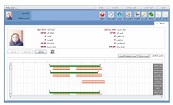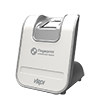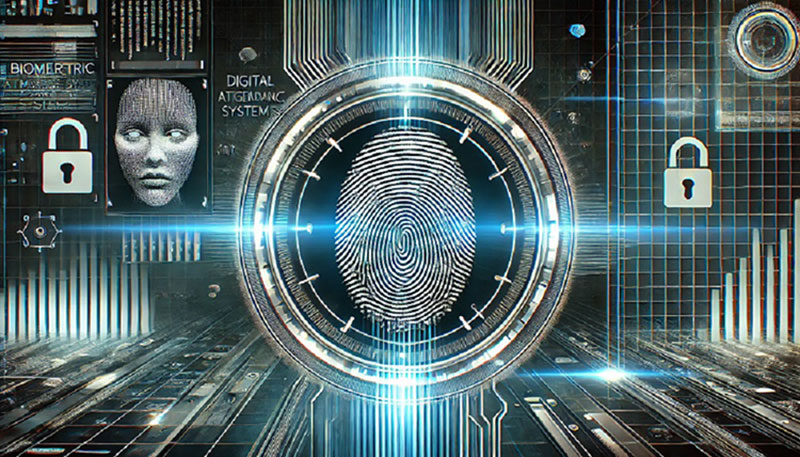This Resource Provides Insights Into:
Introduction to Biometric Attendance Systems
Biometric attendance systems have revolutionized the way organizations track employee attendance and manage access control. These systems leverage unique physiological or behavioral characteristics to authenticate individuals, ensuring a secure and efficient process.
Overview of Biometric Technology
Biometric technology identifies individuals based on unique traits such as fingerprints, facial features, iris patterns, or voice characteristics. Unlike traditional methods relying on cards or passwords, biometric systems provide a more secure and tamper-proof solution. The technology integrates hardware for data capture and software for processing and matching.Biometric technology identifies individuals based on unique traits such as fingerprints, facial features, iris patterns, or voice characteristics. Unlike traditional methods relying on cards or passwords, biometric systems provide a more secure and tamper-proof solution. The technology integrates hardware for data capture and software for processing and matching.
Importance of Attendance Tracking and Access Control in Modern Workplaces
In today’s dynamic work environment, accurate attendance tracking is critical for productivity and operational efficiency. Access control systems play a vital role in ensuring workplace security by restricting unauthorized entry. Biometric systems combine these functions seamlessly, reducing the likelihood of fraud or error.
Key Features of Biometric-Based Systems
- Unique Identification: Leverages distinct traits for precise authentication.
- Tamper-Proof Data: Minimizes risks of manipulation or duplication.
- Real-Time Processing: Provides instant access and attendance tracking.
- Integration Capabilities: Easily connects with HR and security systems.
How Biometric Attendance Systems Work
Biometric attendance systems operate using advanced algorithms and cutting-edge technology to ensure reliability and accuracy.
Types of Biometric Identification
- Fingerprint Recognition: Captures and matches unique fingerprint patterns.
- Facial Recognition: Uses facial features for identification, even with changes in appearance.
- Iris Scanning: Analyzes the intricate patterns in the iris, offering high accuracy.
- Voice Recognition: Identifies individuals through unique vocal characteristics.
Core Technologies Enabling Biometric Systems
- Image Processing: Converts physical features into digital templates.
- Machine Learning Algorithms: Enhances matching accuracy by learning from patterns.
- Cloud Integration: Enables real-time data access and storage.
- Encryption: Secures biometric data during storage and transmission.
Workflow of Data Collection and Authentication
- Data Capture: A biometric device scans the individual’s trait (e.g., fingerprint, face).
- Template Creation: The captured data is converted into a digital template.
- Storage: Templates are securely stored in a database.
- Matching: During authentication, new data is compared with stored templates.
- Access Decision: Grants or denies access based on matching results.
Advantages of Biometric Attendance and Access Control Systems
Biometric systems offer numerous benefits that make them a preferred choice for organizations worldwide.
Enhanced Accuracy in Attendance Tracking
Biometric systems eliminate manual errors and ensure accurate tracking of employee attendance. This precision helps in payroll management and reduces disputes.
Prevention of Time Fraud and Buddy Punching
By relying on unique traits, biometric systems prevent employees from clocking in for others, addressing common issues like buddy punching.
Integration with Organizational Security Protocols
Biometric systems integrate seamlessly with security protocols, ensuring controlled access to sensitive areas and reducing risks of breaches.
Convenience for Users and Administrators
For employees, biometric systems simplify clocking in and out. Administrators benefit from automated data collection and analysis, saving time and resources.
Challenges and Limitations
Despite their advantages, biometric systems face certain challenges and limitations.
Privacy and Data Protection Concerns
The collection and storage of sensitive biometric data raise concerns about privacy and potential misuse. Organizations must comply with data protection regulations to build trust.
Costs of Implementation and Maintenance
Initial installation and ongoing maintenance of biometric systems can be costly, making them less accessible for small businesses.
Environmental Factors Affecting System Accuracy
External factors like lighting, humidity, or physical changes (e.g., injuries) can impact the accuracy of biometric devices, leading to false negatives or positives.
Issues Related to User Adaptability and Reliability
Some users may find biometric systems intrusive or struggle with adaptability. Additionally, technical glitches can affect reliability, requiring robust support systems.
Key Performance Metrics for Biometric Systems
Evaluating biometric systems requires assessing key performance metrics to ensure they meet organizational needs.
Accuracy and Error Rates (FAR, FRR, and EER)
- False Acceptance Rate (FAR): Probability of unauthorized access being granted.
- False Rejection Rate (FRR): Likelihood of valid users being denied access.
- Equal Error Rate (EER): Point where FAR and FRR are equal, indicating system efficiency.
Speed of Recognition and Authentication
The time taken to authenticate users is crucial, especially in high-traffic areas. Faster systems enhance user experience and operational efficiency.
Scalability for Different Organizational Sizes
Biometric systems must adapt to varying organizational needs, from small teams to large enterprises, without compromising performance.
Data Security and Compliance with Global Standards
Ensuring data encryption and adherence to standards like GDPR or ISO/IEC 27001 is essential to protect sensitive biometric information and maintain trust.
Comparative Analysis with Traditional Systems
Biometric Systems vs. RFID-Based Attendance Devices
Biometric systems and RFID-based devices are two prominent technologies for attendance tracking and access control. Biometric systems rely on unique physiological traits, such as fingerprints, facial recognition, or iris patterns, ensuring a higher level of security. RFID-based systems, on the other hand, use radio frequency identification tags or cards that employees carry. While RFID systems are quicker to implement and relatively cost-effective, they are susceptible to misuse, such as card swapping or loss. Biometric systems mitigate these risks by directly verifying an individual’s identity, ensuring a more reliable attendance record.
Benefits Over Password- and Card-Based Methods
Biometric systems eliminate the dependency on external tools like passwords, cards, or PINs, which can be forgotten, lost, or shared. Passwords are prone to breaches, and cards can be duplicated or stolen, leading to compromised security. By contrast, biometric authentication leverages unique physical or behavioral traits, making it inherently more secure and user-friendly. This direct and individual-focused approach reduces operational friction and enhances the integrity of access control measures.
Real-World Examples Showcasing Improved Performance
Organizations worldwide have adopted biometric systems to streamline attendance and enhance security. For example, a manufacturing firm implementing Fingerprint scanners reported a 25% reduction in time theft and improved employee punctuality. Similarly, a government office using facial recognition systems enhanced security by preventing unauthorized access and simplified attendance tracking. These real-world applications highlight the practical benefits of biometric systems in various industries.
Case Studies
Success Stories from Businesses Using Biometric Attendance Systems
Numerous businesses have successfully integrated biometric systems to achieve tangible results. A retail chain, for instance, deployed facial recognition for employee attendance, reducing administrative tasks by 40%. Similarly, a healthcare institution utilized iris scanning to secure sensitive areas, minimizing unauthorized entries by 90%.
Quantifiable Impacts on Productivity and Security
Biometric systems have shown a measurable impact on productivity and security. In offices, automated attendance tracking reduced time spent on manual record-keeping by over 50%, allowing HR departments to focus on strategic tasks. Security-wise, biometric systems decreased instances of workplace theft and unauthorized access by up to 70%, ensuring a safer environment for employees and assets.
Future Trends in Biometric Attendance and Access Control
Role of AI and Machine Learning in Enhancing Biometric Systems
Artificial intelligence (AI) and machine learning are revolutionizing biometric systems by making them smarter and more adaptive. AI-powered systems can now detect anomalies in real-time, such as attempts to use spoofed biometric data. Machine learning models enhance the accuracy of biometric recognition by continuously learning from new data, reducing false positives and negatives.
Multi-Factor Authentication Combining Biometrics and Other Technologies
The future of biometric security lies in multi-factor authentication (MFA). Combining biometrics with additional layers, such as PINs or mobile-based verification, significantly enhances security. For example, using facial recognition alongside a one-time password (OTP) sent to a registered device ensures a robust authentication process.
Integration with IoT and Cloud-Based Solutions
The integration of biometric systems with IoT devices and cloud platforms is set to transform attendance and access control. IoT-enabled biometric scanners can communicate seamlessly with other devices, enabling centralized control and monitoring. Cloud-based solutions offer scalable storage and analytics capabilities, allowing organizations to access attendance data in real-time from anywhere.
Selecting the Right Biometric Device for Your Organization
Factors to Consider: Cost, Features, and Compatibility
When selecting a biometric device, organizations must evaluate factors such as budget, required features, and compatibility with existing systems. Devices vary in terms of biometric modalities, accuracy levels, and integration capabilities. Organizations should prioritize systems that meet their specific operational needs and offer scalability for future growth.
Popular Brands and Their Offerings
Several brands stand out in the biometric industry for their reliable products. Companies like HID Global, Suprema, and ZKTeco offer a range of devices catering to different needs, from fingerprint scanners to advanced facial recognition systems. Comparing features, reviews, and pricing can help in making an informed decision.
Importance of After-Sales Support and Maintenance
Post-purchase support is crucial for the long-term functionality of biometric systems. Regular maintenance, software updates, and responsive customer service ensure that devices operate efficiently and adapt to evolving security requirements. Partnering with vendors who offer comprehensive support can prevent downtime and extend the system’s lifespan.
Conclusion and Recommendations
Summary of Key Findings from the Performance Analysis
Biometric attendance and access control systems outperform traditional methods in terms of security, reliability, and efficiency. They eliminate the vulnerabilities associated with passwords, cards, and manual processes. Real-world implementations have demonstrated significant improvements in productivity and workplace security.
Recommendations for Organizations Considering Biometric Systems
Organizations planning to adopt biometric systems should:
- Assess their specific needs and operational challenges.
- Choose devices that balance cost, features, and compatibility.
- Opt for solutions that incorporate advanced technologies like AI and IoT.
- Partner with vendors offering robust after-sales support and maintenance. By carefully evaluating these factors, organizations can ensure a successful implementation, driving better performance and security outcomes.







































































